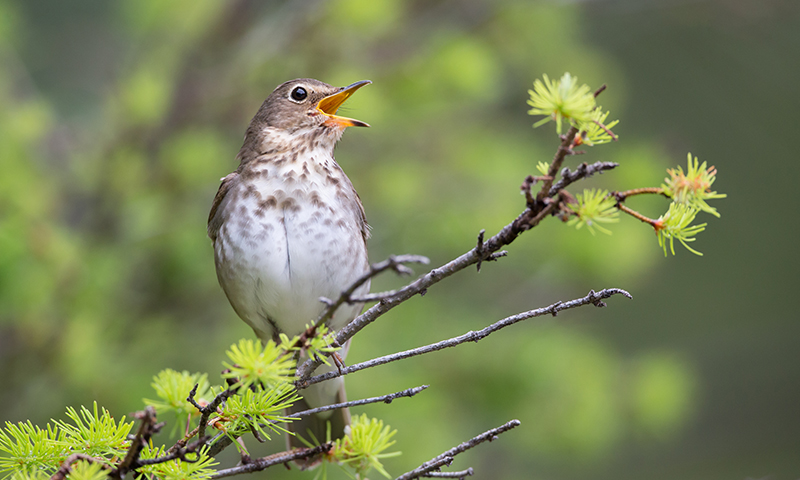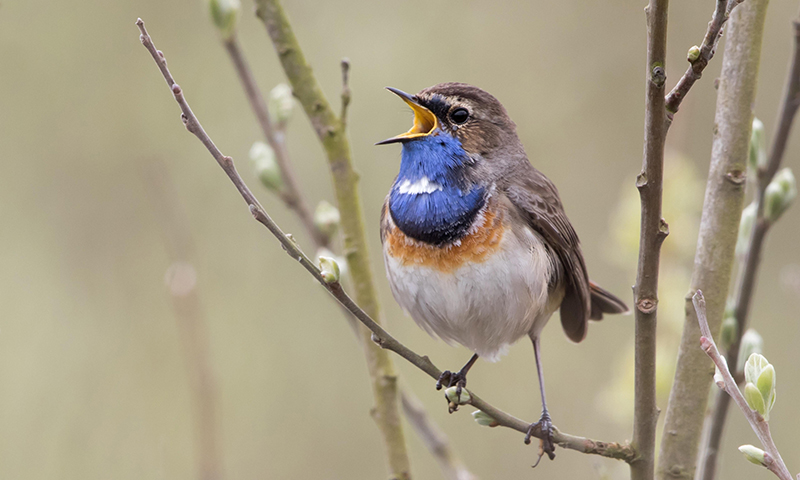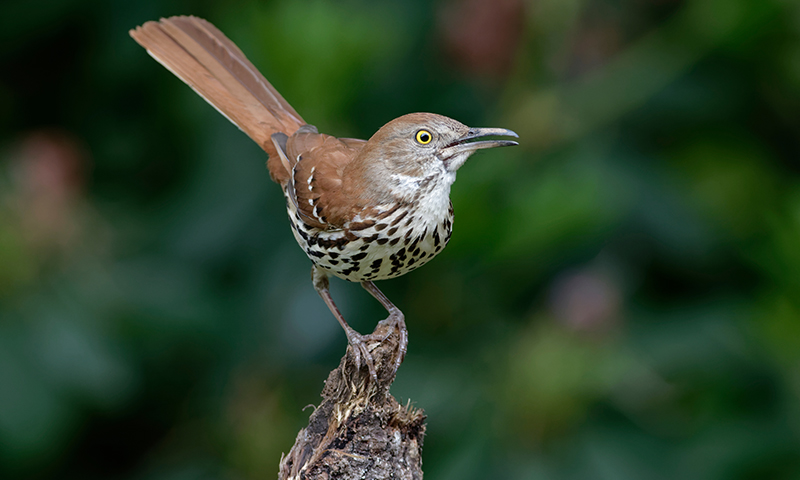All About Thrushes and How to Attract Them
Birders, both new and seasoned, may not realize how many thrushes they've encountered. After all, the thrush family Turdidae includes many species across the Americas, Africa, Europe, Asia, and Australia. Specifically, the Cornell Lab of Ornithology identifies 14 "thrushes and allies" in the Turdidae family found in North America.
Thrushes include popular feathered friends such as the American robin, Eastern/Western/Mountain bluebird, Gray catbird, Greater roadrunner, multiple varieties of thrasher, and so many more.
We visited with Rebecca Lexa, a certified Oregon Master Naturalist who leads guided birdwatching tours, teaches natural history classes, and authored The Everyday Naturalist: How to Identify Animals, Plants, and Fungi Wherever You Go (Ten Speed Press, June 2025), to learn about thrushes.

Swainson's thrush perched on a branch.
How to Identify Thrushes
Since a wide variety of birds are classified as thrushes, each has its own unique characteristics, coloring, and features.
However, many sport various shades of brown and white feathers.
"All thrushes have a similar body shape with a long, straight back and rounded belly, relatively short neck, round head with a large eye and a somewhat long, slender beak with a pointed tip; the top of the beak often curves slightly downward," Lexa shared.
Thrushes have medium-length tails that open into a fan shape in flight. They also have anisodactyl feet with three toes facing forward and one toe facing back to help them perch, swim, walk on the ground, and hunt.
Overall, thrushes tend to measure 7 to 9 inches from beak to tail tip and carry themselves upright as they hop along the ground for food. But they will quickly fly away if they notice a threat, such as a predatory cat.
You might also identify a thrush with your ears.
"Thrushes are known for their beautiful songs, from the lilting tumble of the American robin to the ascending, fluting tones of the Swainson's thrush (Catharus ustulatus). The Song thrush (Turdus philomelos), found in Europe, western Asia, and northern Africa, is even named for its melodious voice," Lexa explained.
Birders in North America have likely spotted the red-orange breast and white eye ring of the American robin. For those in India, the bright blue hues of the Grandala stand out. And, if you spot an all-black thrush, it might just be the Eurasian common blackbird or the Chinese blackbird.
The Cornell University Cornell Lab All About Birds website shares a bird guide for thrushes with photos, audio recordings of birdsong, migration maps, habitat details, and more.
"Thrushes are often overlooked because they are not always the flashiest of birds, and many of them are quite common in their habitats. Yet their brown and white speckled feathers offer them excellent camouflage and mean that many species may be heard but not seen, with an actual sighting becoming quite an accomplishment for a birdwatcher," Lexa shared.

Bluethroat thrush on a budding branch.
Where to Find Thrushes In Nature
If you're on a nature walk looking for thrushes, Lexa says they inhabit temperate, boreal, and tropical areas. You generally won't see thrushes in mountainous or desert regions. However, thrushes do migrate, so you can see them move between areas with winter and summer climates.
Look closely at wooded areas that border open land, such as wild park meadows or groomed suburban lawns free of chemical treatments. Some of the shy thrush species, such as the Wood thrush, like secluded shrubs and underbrush. You might also spot thrushes in grasslands and among wildflowers.
Do you enjoy looking for bird nests? Thrushes build their homes out of plant material, mud, and feathers in trees, shrubs, and the cracks of buildings. They lay a clutch of two to five eggs, and when the babies mature, they follow their parents on their first fall migration trip to a warmer climate, possibly covering thousands of miles. In spring, they return to their breeding grounds.
Birders like to watch for thrushes to return, especially robins. This symbolically signals the start of warmer weather in many regions.

Brown thrasher perched on a stump.
How to Bring Thrushes to Your Backyard
Attract these fun birds to your yard by planting flowers and berry-producing shrubs common to your area. These, in turn, harbor the insects and terrestrial invertebrates (spiders, centipedes, slugs, worms, etc.) that fuel this largely insectivorous family of birds. In the cooler winter months, withered berries serve as much-needed nourishment for thrushes.
"It's crucial you avoid lawn and garden chemicals as much as possible. These chemicals can contaminate the insects and berries the thrushes need and harm the birds," Lexa educated.
You can also bring thrushes to your yard by tempting them with a favorite treat — live mealworms! Thrushes love to forage for insects. Lexa says to place the mealworms on a tray on the ground or simply scatter them in the grass.
"Make sure the robins are nearby when mealworms are put out so they know the food is there; otherwise, the mealworms may escape. If you put mealworms out at the same time every day, they may learn to wait for their treat," Lexa explained. "It is important to not overfeed them so that they do not become completely dependent on you for their food. They need to maintain their ability to forage for a wide variety of insects. Think of the mealworms as a light snack, not as the thrushes' primary fare."
You can also experiment with dried mealworms in various forms.
-
Kaytee Mealworms: These oven-dried mealworms provide protein and energy to wild birds, such as bluebirds, wrens, chickadees, woodpeckers, cardinals, and robins. Parent birds may also use them as food for their young.
-
Kaytee Songbird Seed Cake with Mealworms: If you're working on bringing a variety of songbirds to your yard, this cake filled with dried mealworms, millet, canary grass seed, hulled sunflower seeds, and more will keep them busy pecking at the treats.
-
Kaytee Mealworm Cake: Try this cake made of dried mealworms, sunflower seeds, and safflower seeds. It's a favorite among woodpeckers, chickadees, bluebirds, and robins. Slip it into a suet cake feeder or crumble it on the ground for the thrushes to forage.
Thrushes Help Maintain the Ecosystem
You might wonder how that wild raspberry bush got planted in your favorite park forest or how caterpillars find wildflowers in the middle of a meadow to explore. Thrushes help!
When thrushes eat berries and then defecate the remains (including seeds), it helps to spread berry bushes across a large geographical area naturally.
"But that's not the only way they disperse seeds! As they move around their habitat, they may pick up seeds from grasses and other plants in their feathers or on their legs and drop them someplace else later on," Lexa elaborated.
The eggs of snails and other invertebrates also cling to the legs of thrushes, which then get transported miles away from their original location, helping the ecosystem replenish itself and thrive.
Birders Can Easily Enjoy Thrushes
This family of birds has acclimated to humans in nature and commonly inhabits suburban areas. Many beginning birders add robins, bluebirds, and woodpeckers to their lists of "must-see" birds for good reason. They're easy to attract, spot, and enjoy in parks and yards.
However, Lexa says thrushes often get injured or perish by flying into closed glass windows or get hunted by outdoor cats. Using window coverings such as curtains and shades and keeping close tabs on outdoor pets can help preserve the wild bird population.
Lexa shared, "They deserve as much care and wonder as rarer species, and they are an important reminder that we are still a part of the wider world of nature."
Expand your birding knowledge by reading Backyard Birds' Favorite Bird Seed and Summer Birds You'll Find In Your Backyard This Year.
